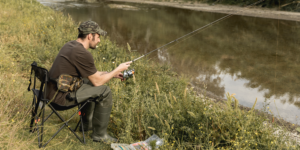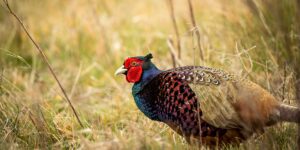Follow these tips to help you bag more birds this fall.
Upland bird hunting, like all hunting, requires understanding of what habitat birds live in, as well as an understanding of how they move and the best way to bring them to bag. Experienced bird hunters have spent years afield studying their quarry, and the best tactics to hunt them. Here are some tips to help you have a successful day afield.
Why limit yourself to public land when there are millions of acres of private land to explore.
Do I Need a Dog?
It’s true that upland hunting is often seen done with a bird dog, whether that be a dedicated flushing or pointing dog. Having a dog definitely brings your odds of finding birds up, but it doesn’t mean you have to have a dog to be successful. A dog has a nose that can smell a bird through the thick cover, but you can also benefit by understanding bird habitat if you don’t have a dog to help you sniff out game. Dogs are also beneficial when it comes to retrieving birds. Oftentimes downed birds blend in with cover, making them hard to see with your eyes. A dog’s nose helps locate shot birds.
Understand Cover
Upland game birds have habitats that suit them, and if you know what habitat birds like to inhabit, you’ll be successful. Do you know what habitats grouse prefer? Do birds hang out in fence lines? Where do wild pheasants feed? Do they prefer heavy cover or open roost sites? Call your local Division of Wildlife and speak to biologists, call your experienced hunting buddy and ask their advice, or just put boots on the ground and work it out for yourself.
The habitats and covers you’re looking for depends on the species of upland bird you are hunting, but a few things are certain: birds want cover and a food/water source. If you find all three, you will find birds.
Be Aware When Birds Are Active
Unlike big game hunting where you’re likely to have to wake up well before the sun rises to hunt, upland bird hunting is different. Upland birds are diurnal, meaning they are only active during the day—and they’re active all day long. You can choose to hunt early to catch the morning dew that will help your dog pick up bird scent and escape the heat of the day, or sleep in and hit the prairies later in the afternoon—it’s up to you. Experienced hunters will help to teach you when thermals are best for dog scenting conditions, what months and weather are best for pheasant hunting or ruffed grouse, and more.
Choose the Right Barrel Choke
You’re going to miss birds—every upland hunter does. But choosing the right shotgun choke size and shot size will greatly increase your chances of connecting on a bird when in hot pursuit. If you’re hunting tight coverts such as thick alders for grouse, choose a more open choke such as a skeet because your shots are going to be inside of 25 yards. If you’re hunting more open landscapes such as prairies for pheasants, you may want to fill your over/under with an improved cylinder and modified choke because shots can be upwards of 40 yards.
Take Your Time
The biggest mistake new upland hunters make is thinking that upland birds fly faster than they really do. Don’t get us wrong, a quail is a fast flying object, but if you take your time and don’t rush the shot, your shooting percentage will go up. On the flush, after your initial shock quickly fades, raise your shotgun and ensure a good gun mount, follow the bird with your barrel until your barrel is swinging at the same speed as the bird, and pull the trigger. If you’re not connecting, you’re most likely behind the bird. Follow the birds head with your barrel, and follow through after you pull the trigger to send your shot string ahead of the bird.
Walk Slowly
What’s unique about upland birds is that they really don’t want to flush and fly—they want to run or hold tight until they absolutely have to fly to safety. Upland birds can huddle under thick cover and you can walk right over them—it’s one way they protect themselves from danger. To help curb this, it’s important to walk slowly and deliberately through thick grasslands. If you hurry your way through, you may have walked right over a couple of birds—and yes, this happens even with good gun dog. A bird may also flush wild if you walk too fast. Upland birds know how to survive and use cover to their advantage. Slow your roll to kick them up.
The hassle free way to monetize your acreage.
Pick Only One Bird
When a covey bursts and flushed birds bust from the brush, you could be faced with 20 bobwhite quail rising or two roosters. It may seem that your shot can bring down multiple birds so you just aim at the group—but that’s exactly how to bring down zero birds. Instead, focus on one bird in the covey and take your time to ensure a good shoulder mount. This practice will bring more birds to bag.
Triple Check the Flush Spot
When a covey flushes, there almost always is a bird that thinks he is smarter than you and is holding tight in that cover hoping that you’ll chase his comrades across the prairie. If you’ve spent your shells, reload before walking to wear the covey flushed. You may just get lucky and have a single bird give you a shot opportunity. Make sure to walk in to the spot in the ready position.
Get in Shape
Upland bird hunting is taxing. You’re walking through thick brush over miles of harsh terrain. Some days you could cover upwards of 7 to 10 miles—or more. It’s vitally important to get you (and your gun dog) in shape before you hit the field. Go on daily walks, or hit the gym, well before upland season. Plan on walking, hiking, or running multiple miles a week. Your muscles will thank you later.
Fire Both Barrels
When you’re new to bird hunting, the surprise of the flush can leave you forgetting that you have two or more shells in your shotgun. If you miss on the first shot, fire again! But don’t rush it. Take your time to get your barrel moving at the speed of the bird and pull the trigger. You have two barrels (or more shells in a semi-auto shotgun) for a reason—use it to bring a long tail down.
Never Shoot a Bird on the Ground
Like mentioned, game birds like to run rather than fly sometimes. Although you want to fill your game bag, stop yourself from shooting an upland bird if you see it running in front of you. It’s ethical to let the bird have a fair chance of flying away, and it’s also just safer, especially if you have a gun dog running in the same cover. If you’re shooting at the ground you’re creating unsafe hunting situations for both you and your hunting partners. Just don’t do it. Also be aware of low flying birds. Let birds fly high before firing. A general rule of thumb is to wait until you see blue sky behind the bird.
Be Quiet
Just like with big game hunting, birds can hear you coming. When you’re laughing with your buddy, or yelling at your dog, you’re letting every upland bird in the area know that danger is near and they need to run or flush wild. Even a slammed truck door can alert birds. Sshhhh! Keep the chatting to a whisper, close your door quietly, and direct your dog with hand signals, collar beeps, or whistles. Don’t yell to your hunt buddy if you can help it—but yelling in excitement when you bring your first upland bird down is allowed and encouraged.
These are just a few tips to help you be more successful this fall. Like all hunting, upland bird hunting takes trial and error—more error than not—to figure out where the birds are and how to find them consistently. Do your research before heading afield to help up your odds of success, be sure to have the proper training and equipment, and have fun!
Why limit yourself to public land when there are millions of acres of private land to explore.



